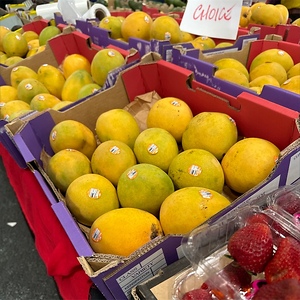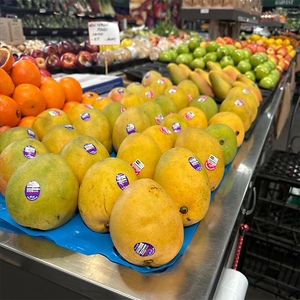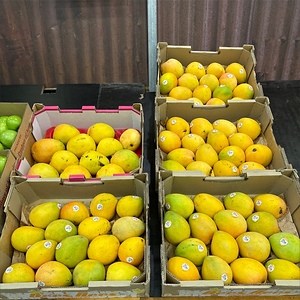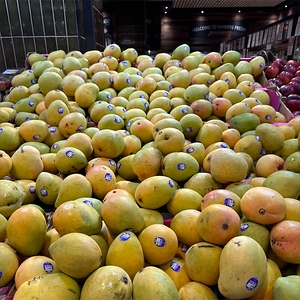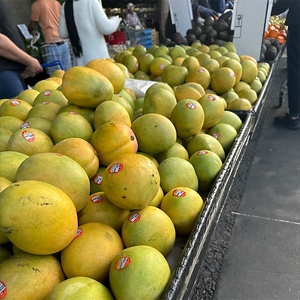


Kensington Pride Mangoes
Estimated Inventory, lb : 0
Description/Taste
Kensington Pride mangoes are generally a medium to large varietal, averaging 200 to 500 grams in weight, but each growing region may produce fruits of varying sizes. The fruits have a uniform, oval, round, to ovate shape with blunt, curved ends. The fruit’s skin is semi-thin, taut, leathery, and tough, ripening from green to golden yellow hues with a bright pink-red blush. The surface is also covered in prominent lenticels and a few light brown markings. Underneath the surface, the yellow flesh is firm when young, softening to a smooth, aqueous, tender, and succulent consistency once ripe. The flesh also encases a small seed tightly adhered in the center. Select Kensington Pride mangoes with a slight give when gently squeezed, indicating ripeness. The variety also has a distinctly sweet, fruity, and citrusy aroma with floral, tropical undertones. Ripe Kensington Pride mangoes have a sweet, tangy, fruity, and floral flavor with subtle spice-filled notes.
Seasons/Availability
Kensington Pride mangoes are available in Australia from September through February. The variety first ripens in the Northern Territory and Queensland, followed by Western Australia and New South Wales. In the northern hemisphere, they are typically in season in June and July.
Current Facts
Kensington Pride mangoes, botanically classified as Mangifera indica, are an Australian variety belonging to the Anacardiaceae family. The sweet, fragrant fruits grow on trees reaching 3 to 7 meters in height and are a polyembryonic variety, meaning their seed will produce multiple embryos, one of which is a genetic clone of the parent tree, a trait needed for propagation by seed. Kensington Pride mangoes are nicknamed the national mango of Australia and are one of the most commercially produced mangoes in the country, accounting for 52 to 80% of the annual mango production, depending on the season. The variety is known by several names in commercial markets, including Kensington, Bowen, Bowen Special, Pride of Bowen, KP Bowen, and KP. Kensington Pride mangoes are named after their site of origination, a property named Kensington in Queensland, and the name Bowen arose from the variety’s main commercial cultivation region near the city of Bowen. Throughout Australia, Kensington Pride mangoes have become synonymous with the summer season and are widely found through local markets and retailers as a fresh-eating variety. The mangoes are also favored for their versatility and are purchased for use in sweet or savory culinary preparations.
Nutritional Value
Kensington Pride mangoes, like other mango varieties in general, may be a source of vitamin C to strengthen the immune system, vitamin A to maintain healthy organs, and vitamin E to guard the cells against the damage caused by free radicals. Mangoes also provide fiber to regulate the digestive tract, calcium to support bones and teeth, potassium to balance fluid levels within the body, and other nutrients, including iron, copper, magnesium, and folate.
Applications
Kensington Pride mangoes have a sweet, fruity, and floral taste suited for fresh and cooked preparations. The variety is primarily consumed out of hand, discarding the skin and seed. Kensington Pride mangoes can be halved, and the flesh scooped from the skin, or they can be sliced into smaller pieces and tossed into salads, slaws, and salsa. Fresh mango is a common topping with herbs over seafood for a tropical twist, or it can be smashed on burgers as a sweet addition. Try blending Kensington Pride mangoes into smoothies, juices, and other beverages. The flesh can also be blended and frozen into granitas, sorbets, and popsicles. In addition to fresh preparations, Kensington Pride mangoes are simmered into jams, jellies, chutney, and compotes. The fruits are also incorporated into sweet desserts, including cakes, cheesecake, pavlova, puddings, crumbles, and bars. Beyond sweet dishes, Kensington Pride mangoes complement savory recipes and are added into noodle and rice dishes, pureed into glazes for roasted meats, or halved and grilled as a savory-sweet side dish. Kensington Pride mangoes pair well with fruits such as coconut, lime, kiwi, orange, and papaya, white chocolate, corn, bell peppers, jicama, tomatoes, and spices such as nutmeg, garam masala, paprika, and cinnamon. Whole, unopened Kensington Pride mangoes should be ripened at room temperature. Ripe fruits can be stored in the refrigerator for a few additional days, but it is recommended to immediately consume for the best quality and flavor.
Ethnic/Cultural Info
Kensington Pride mangoes are famously embodied in a ten-meter-tall mango statue called The Big Mango in Bowen, Queensland. The national landmark was constructed in May 2002 and cost around $90,000 AUD to erect. The Big Mango was built to honor the city of Bowen’s mango history, especially since the city is the hometown of Kensington Pride mangoes. Bowen is also nicknamed the mango capital of Australia for its thriving commercial mango industry. The Big Mango was modeled after Kensington Pride mangoes and was built beside the Bowen Visitor Information Centre as an attraction to boost tourism. Since its creation, The Big Mango has been the subject of two major public events. The first occurred when the statue was being built. Queensland residents often argued over whether the fruit was built upside down or not. Later, in 2014, the statue was stolen one night, spurring a media frenzy that reached an estimated twenty-five million people worldwide. It was discovered that the stolen statue was part of a marketing stunt orchestrated by Nando’s, an Australian restaurant chain, to promote their new mango and lime-flavored sauce. The company returned the statue and also constructed another smaller mango statue in the town center of Bowen. The mango-theft publicity stunt helped to increase tourism to the Bowen area and attract international attention for Kensington Pride mangoes.
Geography/History
Kensington Pride mangoes are native to Queensland, Australia, and are descendants of an unknown variety introduced from Asia in the 1800s. The variety was first discovered in Bowen, Queensland, a city once known for horse-trading. Traders from the British Army in India were often known to travel through Bowen, and they would bring spices and fruits as gifts. In the 1800s, it was thought that a type of Indian or Southeast Asian mango was carried into Bowen and gifted to the Bowen Harbor and Customs Officer, Mr. G.F. Sandrock. It is unknown if Mr. Sandrock actually planted the seed from the gifted fruit on his property or gave the seed to a man named Mr. McDonald for planting in Adelaide Point, but seedlings were cultivated, eventually bearing fruit. Seeds from the best fruits were later given to Mr. William Lott and were planted on his property called Valley Orchard alongside the Lower Don River. Mr. Harry Lott, William’s son, continued his father’s mango cultivation and selectively chose seeds of fruits with desirable qualities, naturally developing a fibreless mango. These selectively bred mangoes were on Mr. Harry Lott’s property, locally known as Kensington, and around the 1880s, his fruits began attracting the attention of markets in Sydney and other growers. Mr. Lott attempted to keep growers from taking the seeds from his mangoes, but eventually, his sister began selling the fruits locally around the Kensington property, spreading the new variety. The new mangoes were called Kensington and Kensington Pride mangoes after Mr. Lott’s property name and quickly became one of the most prevalent mangoes cultivated throughout Australia. Today, Kensington Pride mangoes thrive in subtropical to tropical climates and are commercially cultivated across Queensland, the Northern Territory, Western Australia, and New South Wales. They are also grown in select regions worldwide as a specialty mango. Australia-grown Kensington Pride mangoes are exported to countries in Europe, Asia, and Russia.



